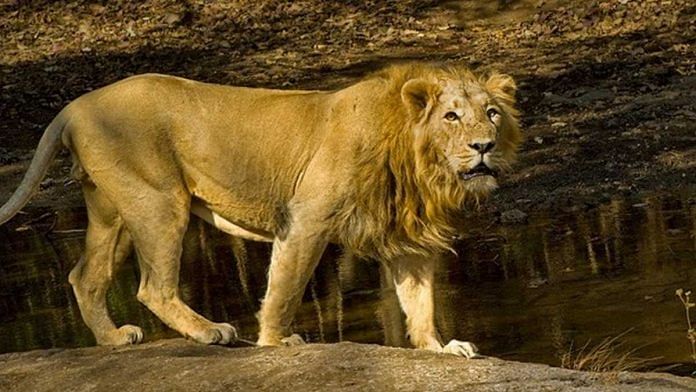New Delhi: The practice of placing food baits for Asiatic lions to bring them closer to the spots frequented by tourists in Gujarat’s Gir forests could be disrupting the animals’ social behaviour — possibly impacting the hunting skills of younger lions, according to a study by wildlife researchers.
Usually, lion density — the number of animals per 100 square kilometre — is heavily influenced by the prey density of an area.
But researchers from the Wildlife Institute of India (WII) found that lions were more abundant in areas where food had been placed to attract animals for tourists to view them.
The findings of the study, published in the journal Plos One last week, suggest that food baits for lions greatly disturb their natural density patterns, their behaviour and social dynamics.
The WII research team also devised an alternative method for monitoring endangered lions in India, which could help improve estimates of their abundance in the country.
The alternative method
As of today, the Gir forests have an estimated population of 500 lions.
The Saurashtra landscape — which covers about a third of Gujarat — is currently the only place where Asiatic lions exist.
According to the WII researchers, conserving this subspecies using the best science and management practices is a global priority.
“Accurate estimates of their abundance are needed in order for conservation efforts to remain successful,” the research team said in a statement.
Existing monitoring methods, particularly a technique known as total counts, can miss some individuals while double-counting others, and they provide limited information on their distribution.
The WII researchers, therefore, demonstrated an alternative method for monitoring Asiatic lions.
Using a computer program, the researchers found a way to identify individual lions with whisker patterns and permanent body marks. They also used mathematical modelling and assessed prey density and other factors that could influence lion density.
The researchers identified 67 individual lions out of 368 lion sightings within a study site of 725 square kilometres in the Gir forests, estimating an overall density of 8.53 lions per 100 square kilometre.
According to the study, the two major natural prey species of Asiatic lions — chital and sambar deer — had a very distinct spatial distribution and density in the landscape.
Chitals prefer valley habitats with good vegetation and water availability, while sambars are found more in rugged and elevated areas.
Since lions primarily live on natural prey in the protected areas, it is expected that lion density would be linked to natural prey distribution. However, this was not found to be true in this study.
“This was likely since lions in the tourism zone got assured food through provisioning and natural prey probably did not regulate lion movement or density,” the researchers wrote in the study.
In many such prides that received such food provisions, the researchers said, younger lions lacked the predatory skills required to hunt as they grow up like scavengers.
“Such animals that lack skills to hunt often come in conflict with humans, as after they disperse from the tourism zone and are no longer provisioned, they try to kill livestock (easier prey) and can also become a danger to human lives,” the study said.
Also read: These wildlife sanctuaries in India could host cheetahs brought in from Africa
Scientific method to estimate lion population is key
The study comes ahead of the lion estimation exercise of 2020, scheduled to begin in May.
According to Qamar Qureshi of the WII, having a robust scientific method to estimate population of lions is key for developing better conservation policies.
Qureshi, who was not involved in the research but has been working on tiger estimation for many years now, told ThePrint that unscientific methods of counting and ‘drum beating’ exaggerated numbers had led the tiger population to completely disappear from Sariska and Panna reserves a decade ago.
At the same time, underestimating animal populations will leave areas around the regions unprepared to deal with possible human-animal conflict in case of overabundance of wild animals.
Also read: Gujarat promotes Gir festival, with lions from Africa and Chicago zoo



